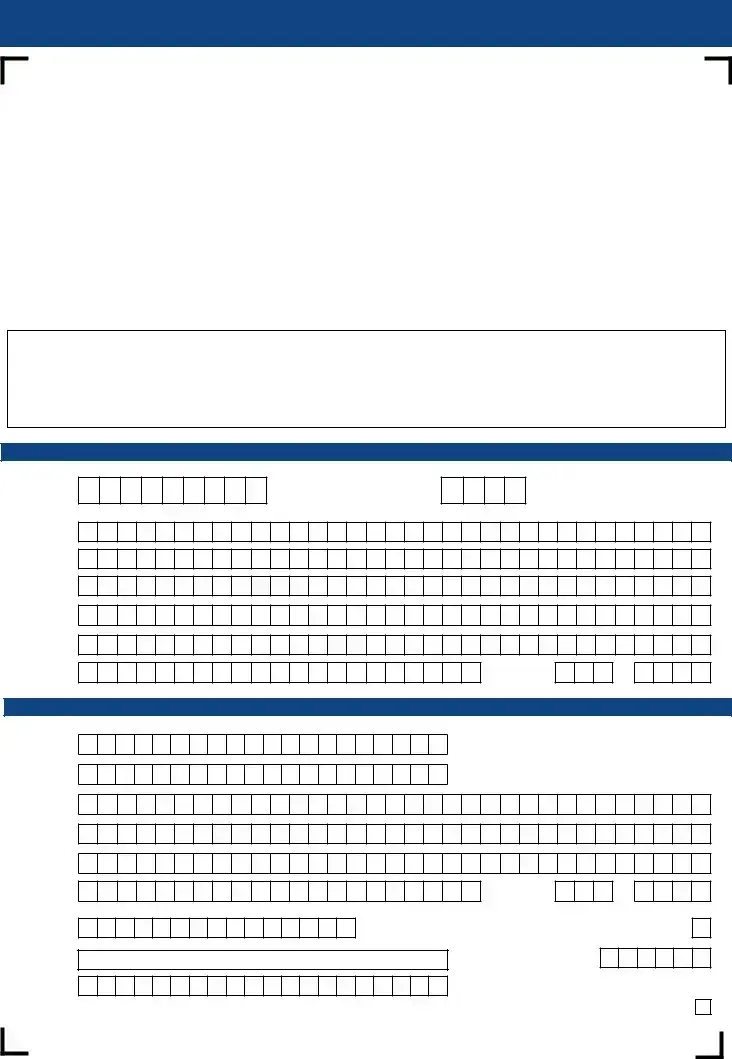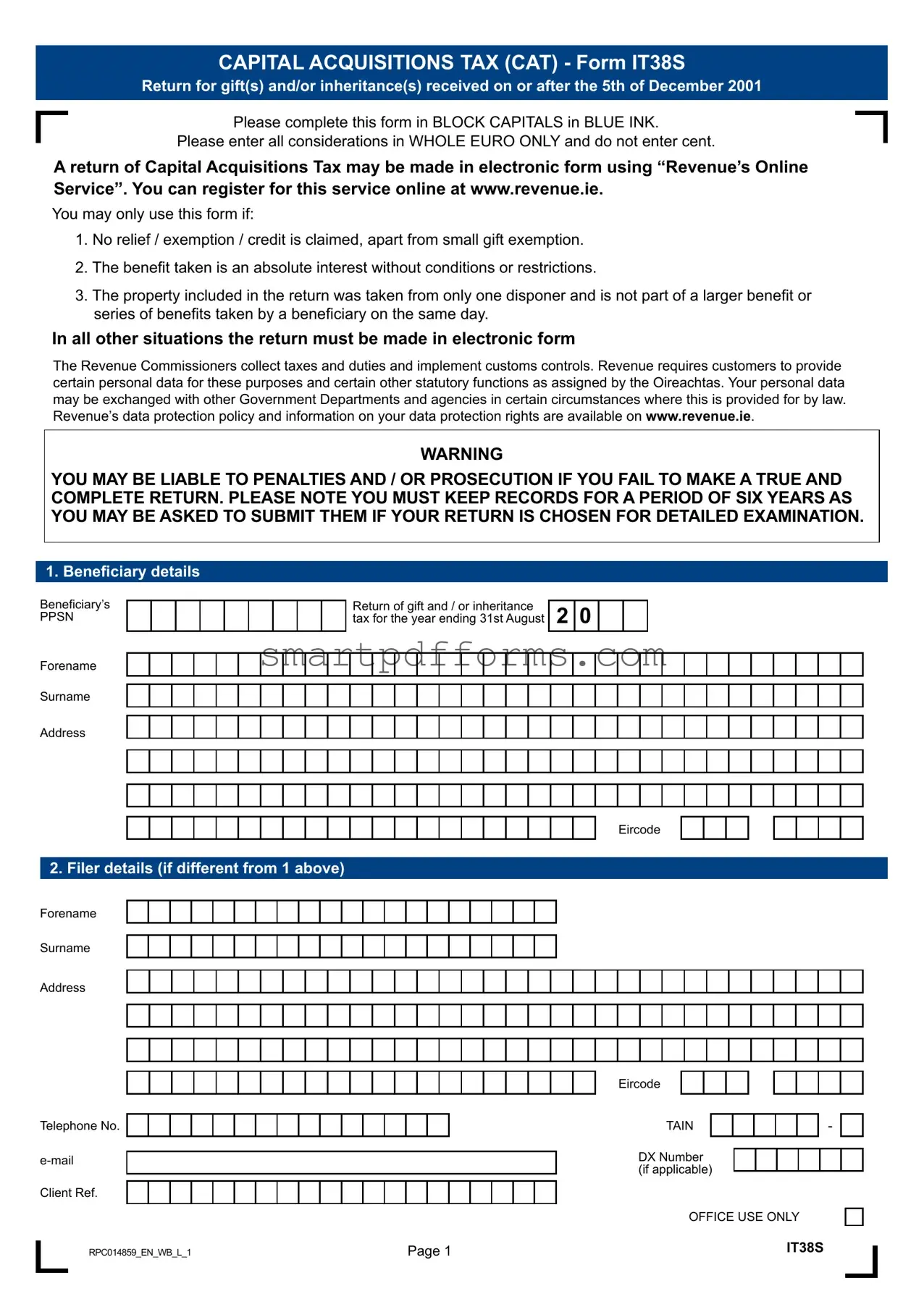
CAPITAL ACQUISITIONS TAX (CAT) - Form IT38S
Return for gift(s) and/or inheritance(s) received on or after the 5th of December 2001
Please complete this form in BLOCK CAPITALS in BLUE INK.
Please enter all considerations in WHOLE EURO ONLY and do not enter cent.
A return of Capital Acquisitions Tax may be made in electronic form using “Revenue’s Online Service”. You can register for this service online at www.revenue.ie.
You may only use this form if:
1.No relief / exemption / credit is claimed, apart from small gift exemption.
2.The benefit taken is an absolute interest without conditions or restrictions.
3.The property included in the return was taken from only one disponer and is not part of a larger benefit or series of benefits taken by a beneficiary on the same day.
In all other situations the return must be made in electronic form
The Revenue Commissioners collect taxes and duties and implement customs controls. Revenue requires customers to provide certain personal data for these purposes and certain other statutory functions as assigned by the Oireachtas. Your personal data may be exchanged with other Government Departments and agencies in certain circumstances where this is provided for by law. Revenue’s data protection policy and information on your data protection rights are available on www.revenue.ie.
WARNING
YOU MAY BE LIABLE TO PENALTIES AND / OR PROSECUTION IF YOU FAIL TO MAKE A TRUE AND COMPLETE RETURN. PLEASE NOTE YOU MUST KEEP RECORDS FOR A PERIOD OF SIX YEARS AS YOU MAY BE ASKED TO SUBMIT THEM IF YOUR RETURN IS CHOSEN FOR DETAILED EXAMINATION.
1. Beneficiary details
Beneficiary’s
PPSN
Forename
Surname
Address
Return of gift and / or inheritance tax for the year ending 31st August
Eircode
2. Filer details (if different from 1 above)
Forename
Surname
Address
Telephone No. e-mail
Client Ref.
Eircode
DX Number (if applicable)
OFFICE USE ONLY
RPC014859_EN_WB_L_1 |
Page 1 |
IT38S |
CAPITAL ACQUISITIONS TAX (CAT) - Form IT38S
Return for gift(s) and/or inheritance(s) received on or after the 5th of December 2001
Beneficiary’s
PPSN
Disponer details
2  0
0 
Disponer’s
PPSN Forename
Surname
Address
|
|
|
|
|
|
|
|
|
|
|
|
|
|
|
|
|
|
|
|
|
|
Eircode |
|
|
|
Place in the appropriate box to indicate the nature of the benefit |
|
Gift |
|
|
|
Place in the appropriate box to indicate whether the property is |
Real Property |
Inheritance
and/or Other Property
Date of gift/inheritance State the valuation date In the case of an inheritance, state the date of the disponer’s death
Place in the appropriate box to indicate the applicable Group Threshold
Information on current group thresholds is available on www.revenue.ie/en/tax/cat/thresholds.html Assessment of Capital Acquisitions Tax
A. Taxable Value of this gift/inheritance
B. Small Gift Exemption (where relevant)
C. Net Taxable Value of the benefit (A - B)
D. Relevant Threshold
E. Less Taxable Value of Prior Aggregable
Benefits within this Group Threshold
Millions Thousands Hundreds
F. Available Threshold for this Benefit (D - E)
G. Taxable Excess (C - F)
Tax on Current Benefit (Rate______%)
Millions Thousands Hundreds
DECLARATION
I/We declare that the information given is true and complete and that the return is in accordance with the provisions of the Capital Acquisitions Tax Consolidation Act, 2003.
Signed
(Agent/beneficiary/trustee, etc.)
D D M M Y Y Y Y
/ 

 /
/
OFFICE USE ONLY
RPC014859_EN_WB_L_1 |
Page 2 |
IT38S |

In accordance with section 46 of the Capital Acquisitions Tax Consolidation Act 2003, a person who receives a gift or an inheritance with a valuation date in a year ending 31 August is required to pay gift or inheritance tax and file a tax return by the following
31 October.
All returns may be made in electronic format. However, you may use the attached paper form only if you meet the 3 conditions outlined at the top of the form.
In completing the payslip below, the name and PPSN to be entered are those of the beneficiary.
How to complete the payslip
You can ensure that your Capital Acquisition Tax payments are promptly and properly processed by completing the payslip below and forwarding it to the Collector-General, PO Box 354, Limerick.
Please enter an amount in the relevant space on the Payslip for the following:
1. Inheritance Tax
This is the amount of Capital Acquisitions Tax payable on inheritances received with valuation dates arising in the year ending
31August.
2.GIFT TAX
This is the amount of Capital Acquisitions Tax payable on gifts received with valuation dates arising in the year ending 31 August.
3. TOTAL NET AMOUNT
The Total Net Amount figure is the total Capital Acquisitions Tax payable comprising Inheritance Tax and Gift Tax.
|
|
|
|
|
|
|
|
€ Payslip |
Return of gift and/or inheritance tax |
|
|
|
|
|
|
|
|
|
|
|
|
2 |
0 |
|
|
|
|
|
|
|
|
|
|
|
|
|
|
for the year ending 31st August |
|
|
|
|
|
|
|
|
|
|
|
|
|
|
|
Inheritance |
|
|
|
|
|
|
|
|
|
|
|
|
|
|
|
|
|
|
|
|
|
|
|
|
|
|
|
|
|
|
|
|
|
|
|
|
|
|
|
|
|
|
|
|
|
|
|
|
.00 |
|
|
|
|
|
|
|
|
|
Tax |
|
|
|
|
|
|
, |
|
|
|
|
, |
|
|
|
|
|
|
|
|
Gift Tax
TOTAL NET
AMOUNT
PAY AND FILE - 31 OCTOBER
Please read the important information on this page before completing the payslip overleaf
IMPORTANT |
Methods of Payment |
|
|
You can make a payment against a tax liability using one of the following:
1. Revenue On-Line Service
For details on how to submit returns and make payments using the Revenue On-Line Service (ROS) visit the Revenue website at www.revenue.ie or phone 01 738 3699.
2. Cheque
All cheques should be made payable to the Collector-General and forwarded to the address below, with the completed payslip.
Do not enclose cash.
Importance of Prompt Payments
■Make sure that you allow sufficient time - at least three working days - for your payment to reach the Collector- General by the due date.
■Late payment of tax carries an interest charge.
■Failure to pay a tax liability, or failure to pay on time, can result in enforced collection through the Sheriff, Court proceedings or Attachment.
Enforcement carries costs, additional to any interest charged.
ENQUIRIES
Any enquiry regarding liability should be addressed to your local Revenue Office.
Any enquiry regarding payment should be addressed to the Collector-General, Sarsfield House, Limerick.
Please return the payslip with a payment to:
COLLECTOR-GENERAL, PO BOX 354, LIMERICK



 0
0 


 /
/
 0
0 



